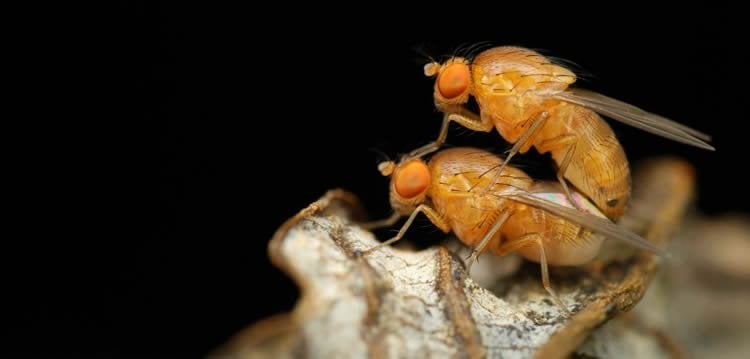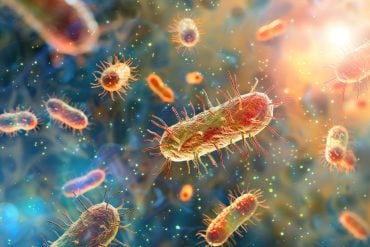Summary: Researchers have identified a neural pathway in male fruit flies that allows them to perform their complex mating ritual.
Source: University of Oxford.
Scientists have identified the neural pathway in male fruit flies that allows them to perform their complex mating ritual, paving the way for deeper studies into sexual behavior and how it can be modified by social experience.
A gene known as doublesex is responsible for the differences in anatomy and behaviour of males and females in many animal species. The male doublesex gene is active in around 650 neurons – specialised cells that transmit nerve impulses – with specific groups of cells controlling distinct steps in the courtship ritual. However, it was not known how these different steps are coordinated to ensure successful mating.
“Male fruit flies court females with a series of ‘hard-wired’ or genetically programmed behaviours, and failure during any part of the process may prevent reproduction,” says senior author and Wellcome Trust Senior Investigator Stephen Goodwin, from the Centre for Neural Circuits & Behaviour at the University of Oxford.
In their study, Goodwin and his team identified a circuit of doublesex-expressing neurons in males that controls the act of sex itself. Located in the fruit fly’s equivalent of the spinal cord, this circuit is made up of three key types of neurons: motor neurons, inhibitory interneurons, and mechanosensory neurons.
Hania Pavlou, lead author of the study and MRC Career Development Postdoctoral Fellow in Computational Genomics, added: “We found the exact motor neurons that control the male penis and enable sex to take place, in addition to a second group of inhibitory neurons that oppose the motor neurons and are involved in the uncoupling following sex.
“Using sophisticated genetics, we are able to perturb the activity of these neurons and stop males from mating. We also show that the mechanosensory neurons on the genitals feedback and potentially coordinate the activity of the other neurons to generate the correct balance of excitation and inhibition that is needed for copulation.”

The results suggest the doublesex gene configures a circuit specific to males, which allows them to successfully execute the correct action sequence for both the initiation and termination of sex.
The findings also indicate that the mechanics of copulation are separate from those of reproduction.
It has previously been shown that sperm transfer in fruit flies is controlled by a group of neurons that supply the reproductive glands with nerves and promote ejaculation. The new study reveals that the circuit controlling the act of sex is distinct from that involved in sperm transfer, although it may still help to modulate it. This suggests a mechanism for separating the pleasant sensation of sex from reproductive function.
Identifying the neural circuits that drive behaviours in fruit flies can provide scientists with an insight into the universal principles of how a nervous system can coordinate complex motor behaviours, such as walking, flying and sex.
Funding: The full study, which was funded by the Wellcome Trust.
Source: Stuart Gillespie – University of Oxford
Image Source: This NeuroscienceNews.com image is adapted from the University of Oxford press release.
Original Research: Full open access research for “Neural circuitry coordinating male copulation” by Hania J Pavlou, Andrew C Lin, Megan C Neville, Tetsuya Nojima, Fengqiu Diao, Brian E Chen, Benjamin H White, and Stephen F Goodwin in eLife. Published online November 15 2016 doi:10.7554/eLife.20713
[cbtabs][cbtab title=”MLA”]University of Oxford. “How the Brain Coordinates Copulation.” NeuroscienceNews. NeuroscienceNews, 16 November 2016.
<https://neurosciencenews.com/neuroscience-copulation-5537/>.[/cbtab][cbtab title=”APA”]University of Oxford. (2016, November 16). How the Brain Coordinates Copulation. NeuroscienceNews. Retrieved November 16, 2016 from https://neurosciencenews.com/neuroscience-copulation-5537/[/cbtab][cbtab title=”Chicago”]University of Oxford. “How the Brain Coordinates Copulation.” https://neurosciencenews.com/neuroscience-copulation-5537/ (accessed November 16, 2016).[/cbtab][/cbtabs]
Abstract
Neural circuitry coordinating male copulation
Copulation is the goal of the courtship process, crucial to reproductive success and evolutionary fitness. Identifying the circuitry underlying copulation is a necessary step towards understanding universal principles of circuit operation, and how circuit elements are recruited into the production of ordered action sequences. Here, we identify key sex-specific neurons that mediate copulation in Drosophila, and define a sexually dimorphic motor circuit in the male abdominal ganglion that mediates the action sequence of initiating and terminating copulation. This sexually dimorphic circuit composed of three neuronal classes – motor neurons, interneurons and mechanosensory neurons – controls the mechanics of copulation. By correlating the connectivity, function and activity of these neurons we have determined the logic for how this circuitry is coordinated to generate this male-specific behavior, and sets the stage for a circuit-level dissection of active sensing and modulation of copulatory behavior.
“Neural circuitry coordinating male copulation” by Hania J Pavlou, Andrew C Lin, Megan C Neville, Tetsuya Nojima, Fengqiu Diao, Brian E Chen, Benjamin H White, and Stephen F Goodwin in eLife. Published online November 15 2016 doi:10.7554/eLife.20713






